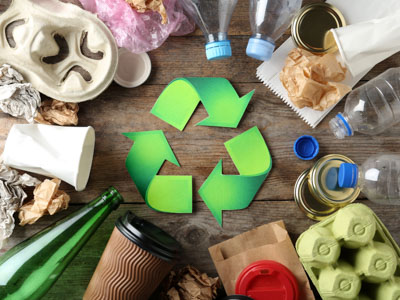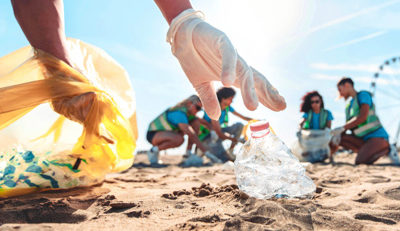6 recycling myths debunked
“Recycling is a bad idea“, said no one ever? Whilst recycling technology keeps evolving rapidly, some recycling myths have been proving hard to kick. So what are the most common recycling myths and is the reality as black or white as many think?
Now, don’t take me wrong. Do I think that recycling is the solution to all our problems? After all NAYAVITA eco towels are made 100% from recycled plastic waste. No, I don’t.
The avoidance of waste generation i.e. pre-cycling, is arguably the way forward. But in the absence of everyone leading a zero waste life-style, recycling is the way to stop our planet from becoming an uninhabitable wasteland. After all, where else will the waste go.
Or does anyone really still think that air pollution caused by incineration and landfills are a better alternative for life on our planet?
So what are the six most common recycling myths?
Myth no. 1 – Recycling uses more energy than new item production
Let’s dive right in with one of the biggest recycling myths there is.
Did you know that recycling aluminium cans saves 95% energy you would otherwise need to produce new cans from raw materials? Tin and steel can recycling saves around 70%, plastic and glass 30-35% and recycling paper saves approximately 60% of energy compared to producing these items from virgin resources.
Even if you omit the energy saving aspect, there are significant water savings, not to mention that raw materials are not infinite. Recycling what we already have means we don’t need to plunder our natural resources to produce new stuff.
True, collecting and sorting recyclables also takes energy. And when you throw the wrong trash into a recycling bin, you might just contaminate the load beyond salvation and it will lead to even bigger waste of energy and end up in a landfill anyway.
Great. But let’s look at this holistically. Should we really throw away the baby with the bath water just because it cannot walk yet?
Myths no. 2 & 3. – Everything can only be recycled once and the quality declines
Glass, aluminium cans and other metals are outliers in the recycling world. All can be recycled indefinitely, without loss in quality. Combine that with the energy and water savings we already talked about, and you know who the Oscar, Grammy and Bafta for most recyclable materials go to.
Thanks to advancements in recycling, the quality of products from other recycled materials is also constantly rising. Paper nowadays can be recycled more than five times, before the fiber degradation makes it more suitable for packaging inserts and egg cartons. That is significantly more than a couple of decades ago.
Plastic, unfortunately, is on the other side of the spectrum to glass and aluminium. Polymers contained in plastic break down through the recycling process, making it no longer suitable for food and beverage packaging. In short, single use plastic like PET bottles will unlikely recycle back into their original form. More likely, they will be turned into microfiber fabric like our beach towels and yoga mats, an insulation, plastic lumber for constructions and park benches, or will be mixed into other more durable materials like road asphalt.
So what’s the lesson here? If you cannot help yourself buying new things, in particular those of single use, favour more sustainable alternatives to plastic with longer overall life-span.
Myth no. 4 – All recyclables must be spanking clean before recycling
Another of the recycling myths that keeps coming up is recyclable cleaning. Let me start by saying that you should always give your recyclables a rinse. That does not mean you need to treat all your waste to a hot soapy bath. But removing most food and other residue improves the quality of recycled content. Not to mention making your waste safer to sort on manual sorting lines.
Although location-dependent, many recycling plants include waste cleaning as part of the process. Minor contamination is therefore usually not a problem. Though be aware if you exceed that elusive ‘clean enough’ threshold, you are potentially sending the whole batch for incineration or to a landfill.
Here are some useful tips how to clean different types of waste. This is particularly important if your area uses single-stream recycling system.
One thing you always need to avoid is grease. That applies to grease residue on all materials from pizza boxes and oil bottles to accidentally mixed in food waste. If you don’t feel like washing that oil bottle, better throw it into communal waste. That way you will not contaminate the whole load and so outdo the good of others. Same goes for other heavily soiled recyclables and overly wet items.
But doesn’t rinsing waste negate the reveled water savings?, I hear you ask. Use dish water or other waste water already destined for the drain and feel like that sustainability ninja I know you can be.
Myth no. 5 – Only things made from a single material can be recycled
When recycling started, technology was still in its infancy and recycling multi-material items was one for the future. Well, the future is now.
Technology has evolved. In most places, we no longer need to separate the plastic window from envelopes, staples from paper and caps from plastic bottles.
Even the baffling drink cartons are now accepted for recycling in many locations, either separately or as part of paper or plastic collection. Whilst historically, their 75% fiber content was the most sought-after recyclable, Tetra Pak’s partnership with Veolia promises to find recycling solution for the remaining 25% comprising of polymer and aluminium mix.
Despite the advancements, recycling rules and processes are not globally uniform. And there are still items that have been eluding the recycling industry. Bubble envelopes require you to separate paper and plastic layer, some plastic toys are simply too complex to recycle, and as for garden hoses and mirrors, they still belong to a communal waste.
Myth no. 6 – Every plastic is recycled
Whilst most plastic is recyclable, whether it will be recycled is another question. Several factors are at play here.
Out of the 40 000 types of plastic in existence, some plastic is just too difficult to recycle, which makes it economically nonviable. According to Joe Allen from The First Mile recycling company, each type is treated with different chemical process and bound together in different ways, requiring very different recycling methodology. So whilst in theory any plastic can be recycled, practice lacks behind.
Each country, region, and sometimes even town determines what gets recycled. This is driven by the recycling capabilities of their contracted recycling partners. That is why in some places, you are strictly required to only recycle PET bottles, whilst other accept myriad of plastic. Always check with your local authority to be up to date with what is acceptable in your area.
Recyclables are commodities, and their market value is another important factor. Recycling companies clean, sort, and press recyclables into neat cubes of singular waste, ready for manufacturing companies to buy them. Not all types of plastic are viable for manufacturers to process into something shiny and new. The resulting lack of demand means these materials end up incinerated or in landfills, which makes economically more sense.
We hope this helped to demystify the 6 most common recycling myths.
In conclusion
Despite the advancements in recycling technologies, increasing number of manufacturers including recycled materials in production and growing demand from consumers, solely recycling is not the silver bullet we might wish it to be.
The way to tackle the growing waste conundrum is for manufacturers, consumers and governments to work together. Only this way can we drastically reduce the generation of waste, and especially plastic.
Eliminating single-use plastic through laws and regulations, making better choices as customers and designing products to be reusable are all good step.
And where recycling is the only option, producers and manufacturers need to work towards making easily recyclable non-toxic plastic alternatives and single-material products, further lowering barriers to recycling.






